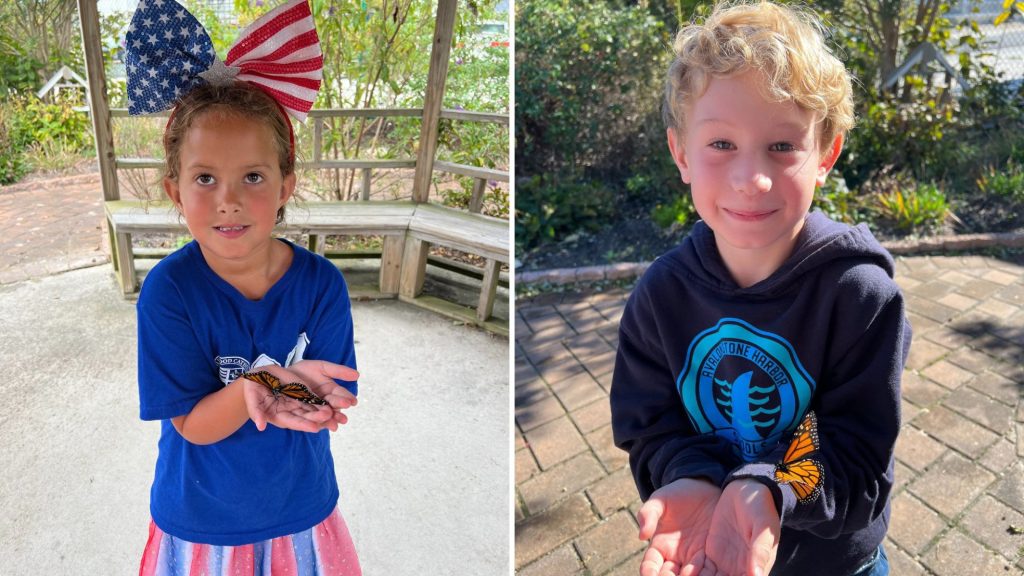STONE HARBOR – The 16 or so kindergarten students who attend the Avalon and Stone Harbor Elementary School (K-4) each year have probably helped hundreds of monarch butterflies on their way toward a 2,500-plus-mile flight to the mountains west of Mexico City.
The Kindergarten Monarch Project was started about 17 years ago by then-kindergarten teacher Roberta Dean. Paraprofessional aide Susan Jones, who is in her 23rd year at the school, recalled the project that is still going on years after Dean’s retirement, even with the current kindergarten teacher out on maternity leave.
Jones said the project begins in September, as soon as the children are in school, and runs to about mid-October.
“We have milkweed growing in the school garden and around the school,” Jones said. “Milkweed is the only thing monarchs eat.”
As a class, the students go out and gather caterpillars or their eggs and bring them into the classroom. The children are able to see the caterpillars and watch their progress through their entire lifecycle – from egg to larva to pupa and butterfly. The pupa stage is midway between larva and butterfly when a hard shell called a chrysalis is formed. In roughly four weeks, a butterfly will emerge from the chrysalis and will be ready to be released.
In the meantime, the children collect fresh milkweed every day and place it in the monarch cages in their classroom.
“The kids can see the eggs and how tiny it is when it comes out and all the stages, as the caterpillar goes into the chrysalis and comes out as a beautiful butterfly,” Jones said.
The students release the butterflies into their school garden, where they started as eggs, and watch them fly off, heading toward the Oyamel fir forest west of Mexico City.
On their way, they could encounter individuals from the Cape May Monarch Monitoring Project who might trap them at the Cape May Point State Park and tag them before they head across the Delaware Bay on their way to the Mexican forest. Jones said the forest virtually turns orange with monarchs.
Current kindergarten teacher Brie Schenck said the project has been a great way to get the children involved and interested in school. Now in her sixth year, Schenck said she continued the program, with Jones’ help, that Dean began.
“Sue (Jones) was Roberta’s (Dean) aide, and she makes sure the project is going right,” Schenck said.
When asked how the children like the project, Schenck had just three words.
“They love it,” she said.
Schenck said from day one, they introduce the children to the project. The students come in and they tour the kindergarten classroom and see the elements of the project. Schenck said the project helps create an atmosphere of fun learning from the very first class.
“Some kids get nervous on the first day, but to see caterpillars and butterflies, it brings science to life before their eyes, and it’s just a more welcoming atmosphere for the start of the school year,” she said.
Schenck said elements of the project are incorporated into all aspects of the curriculum of the monarch project: The Spanish teacher has the children learn songs in Spanish, the art teacher has them making monarch butterfly puppets, they read about the life cycles, they talk about what the butterflies like to eat, and, again, get to see the entire life cycle of the monarch butterfly.
Schenck said the Avalon and Stone Harbor Elementary School is unique in the fact that it has a milkweed garden. She said other schools do a monarch project, but they must mail away for the eggs.
Schenck said Jones, who has been with the project from its inception, is able to tell the students which butterflies are boys or girls. She said this information is shared with the Wetlands Institute.
Jones has some other insight for the children – some predators do not like the sour taste monarch butterflies acquire from eating milkweed.
The kindergarten always sings a goodbye song to the monarchs as they are released.
Contact the author, Christopher South, at csouth@cmcherald.com or 609-886-8600, ext. 128.








